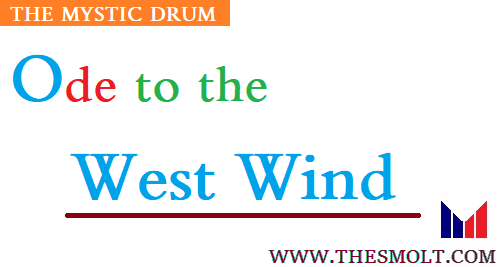Ode to the West Wind
Ode to the West Wind is a romantic poem that is composed by P.B. Shelley and is distinguished among the Romantic poets of the early 19th century by his revolutionary idealism. In both Prometheus Unbound and “Ode to the West Wind’ this idealism is best reflected.
His poetry is characterized by beautiful imagery and fine music. He presents a contrast with Keats. Shelley was general and abstract, and Keats was specific and concrete.
Keats had advised Shelley to “curb his magnanimity and be more of an artist, and load every rift with ore”. “Ode to the West Wind” is considered one of the most perfect lyrics in English poetry. Among Shelley’s poems also, this Ode occupies the highest place.
The poem was composed in October 1819, in wood along the Arno river near Florence. Shelley had gone there with his wife Mary; Shelley, who was expecting a child. Ode to the West Wind
Ode to the West Wind Analysis by P.B. Shelley (click)

At about this time, however, Shelley was in a despondent mood because of the loss of his children in the recent past and the bitter attacks of the critics on his poetry.
Critical Appreciation of Ode to the West Wind
In this poem he was trying, as it were, to overcome his mood of despondence, by invoking the regenerative power of Nature. “Ode to the West Wind” is, perhaps, the most perfect of Shelley’s poems. It epitomizes Shelley’s philosophy of life and art.
It is the clearest and most perfect illustration of Shelley’s idealistic faith in the regeneration of mankind and the role of the poet in such regeneration. The West Wind becomes a symbol of the regenerative power of nature.
The west wind in the autumn strips old foliage from the trees and scatters the seeds of future growth. At the end of the poem, Shelley says: “Let me be the voice of the West Wind, spreading among mankind the prophecy of a new and better world’.
He identifies himself (the poet) with the mighty spirit of the West Wind, which is only a manifestation of nature’s power and implores it to be the messenger of revolutionary ideas. “Ode to the West Wind” is divided into five stanzas, each consisting of only fourteen lines as in a sonnet.

Each of these sonnet-like stanzas in the poem is built of three tercets of terza rima plus an ending couplet. (A tercet is a stanza of three lines linked by rime, as in Terza rime, which again is a series of interlocking tercets through the rime pattern, e.g. ABA, BCB, CDC, and so on). The structure of this Ode is interesting for its experimentation with the sonnet form.
Each stanza of this Ode is thematically unified. In the first three stanzas, we have three “episodes’ of the leaf, the cloud, and the wave. In the fourth stanza, these three motifs are fused in the identification of the poet with the west wind, which is the overall unifying force. In the final stanza, the poem becomes a prayer.
The final stanza provides the climax of the poem where the identification of the poet with the west wind is complete: Ode to the West Wind
Be thou, Spirit fierce,
My spirit! Be thou me, impetuous one!
“Ode to the West Wind” is one of the finest lyrics in English poetry. It epitomizes Shelley’s revolutionary ideas and is a great poem, particularly for its colorful and scintillating imagery and its deep sonorous music. Ode to the West Wind
Read more from Mystic Drum (click)